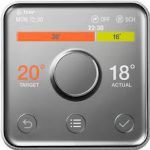All our houses have controllable gas central heating and double glazing.
This post tells you a little bit about controlling your heating and ensuring proper ventilation.
All our central heating systems are set to maintain the house at an average of 21 degrees, the government recommended temperature for living spaces.
The Central Heating Controller
The over-all temperature for the house is set by the main house central heating controller. You can turn the over-all house temperature up or down from 21 degrees using the main house digital thermostat which controls when the boiler is on. Most of the time you don’t need to adjust it as it’s set to maintain the correct temperature, but if you do need to adjust it occasionally then it’s very simple.
Most of our houses have a Hive controller which you can easily adjust as below. A couple of our houses have a Tado system which you control using an app on your mobile phone. Please speak to you landlord for the password if you have a Tado controlled system.
 |
You can usually find this Hive heating controller in the main living room or lower hallway.
Turn the central knob clockwise to increase the target temperature and anti-clockwise to reduce the target temperature; the display will light up when you start to turn the knob and will show you the current (actual) temperature at the right. Continue turning the knob and when the “target temperature” displayed on the left is at the desired temperature then just leave it and that will be set and the display will turn off after a few seconds. |
When the thermostat detects the house is cooler than the desired temperature it will turn on the boiler to heat the house until it reaches the desired temperature. This is measuring the temperature at the house thermostat not in your individual room. Remember that the heat isn’t “instant” and although the radiators will usually start to warm up within 5 or 10 minutes it may take an hour or so for the house to reach the desired temperature. Turning the house thermostat up to a high temperature doesn’t make the house heat up any quicker and it should never really be necessary to turn it above 23 degrees at the most.
Controlling your individual room radiator
 |
You can control the individual temperature of your room with your radiator thermostatic valve. This will look similar to the valve pictured and is usually numbered from 1 to 5. The higher the number, the warmer your room will get.
Normally you should set the valve to 4 or 5 in the day to keep the temperature around 21. The government recommended temperature for comfortable sleeping is around 18 degrees so we recommend you turn your valve down to around 3 in the night to reduce the room temperature. In summer it’s usually warm enough not to require heating so we recommend that you keep your radiator thermostat set to 2 to prevent your room over heating. In winter it’s important that your room is kept warm enough to prevent pipes freezing so NEVER set your radiator valve to less than 2. |
If you are sitting in a t-shirt and shorts with your heating on full blast you are contributing to global warming. England is cold; you are definitely going to have to use central heating to keep your house warm in the colder months. However, we can all improve on our use of gas and electricity when it is not necessary.
Ask yourself a couple of sensible questions before before turning the heating up! Are you wearing adequate clothing; should you put on another layer of clothing or get a blanket? Are all your doors and windows closed to keep heat in? By thinking first you’ll see a reduction in your bills and also will relinquish your reliance on energy dependent heat sources!
Remember that although heating is included in your rent, it’s not an unlimited amount so turning up the heating too much could mean you spend more than the allowance and you may then have to pay extra. If you use the heating sensibly, maintaining around 21 degrees then you shouldn’t get any unwanted extra bills.
Ventilation
 |
All our houses have energy efficient double glazing. This is less draughty and warmer than standard windows and helps prevent heat escaping from your room.
To maintain a healthy environment we do however recommend that you open the window for a few minutes every day to let in some fresh air and let out excess humidity. It’s important to let out the humidity as constantly high humidity can cause black mould which is not good for your health. If you room feels “sweaty” that’s an indicator of high humidity and openning your window for a few minutes will sort this. It’s particularly important to control the humidity if you have an ensuite shower room as showering creates a lot of steam. Always ensure the ensuite extractor fan is on while showering and for 10 minutes afterwards and if your room still feels humid then open your window for a few minutes. If you open a window in your bedroom or a shared room like a bathroom, kitchen or living room ALWAYS remember to fully close and lock it before you leave. If it’s not fully closed and locked you won’t be insured in the event of a theft and it can also waste a lot of heat and generate unpleasant draughts round the whole house. |
